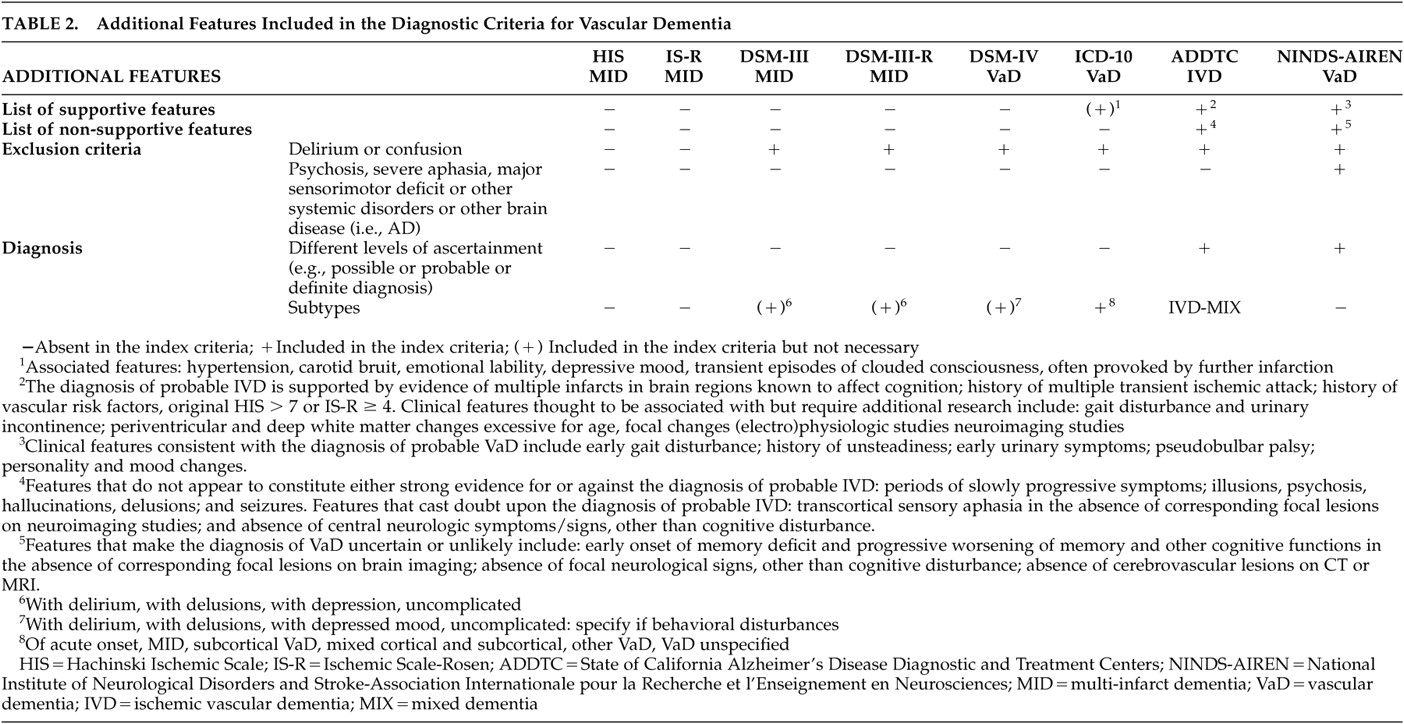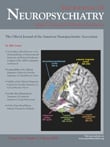To our knowledge, this is the first qualitative review aimed at describing and comparing the symptom requirements of eight different clinical criteria used for the diagnosis of vascular dementia. Critical issues regarding the definition of the cognitive syndrome and the vascular causes were differentially described in an effort to contrast them with current evidence reported in literature. To require the primacy of memory impairment in vascular dementia, an aspect not established on an empirical basis, induces problems that Looi and Sachdev
28 underlined a few years ago. These problems include: some patients with significant cognitive decline will not be diagnosed as having vascular dementia if their memory functioning is relatively well-preserved; in requiring memory impairment, the criteria may result in selection of the more severely cognitively impaired patients, precluding attempts at primary prevention; and the heterogeneity of cognitive impairment due to cerebrovascular lesions is likely to be underemphasized.
The reliability of the clinical diagnosis of Alzheimer’s disease has partially derived from the predictable nature and location of its neuropathology,
66 which typically starts in the limbic system and affects episodic memory primarily and most severely. Such has not been the case with respect to the diagnostic criteria for vascular dementia. Neuropathological validation was seldom carried out before the implementation of the criteria. All these clinical diagnostic criteria have been consensus criteria that were neither derived from prospective community-based studies with clinico-pathological correlations of vascular factors affecting cognition nor based on detailed natural histories.
67,
68 In fact, the absence of a single, generally accepted, highly effective diagnostic methodology for vascular dementia clearly suggests a lack of consensus among clinicians and researchers,
69 and has made it very difficult to develop criteria for a prodromal state of vascular dementia. In addition, the available diagnostic criteria were all based on the ischemic infarct concept and have had limited validation.
68,
70 The specification of the neuropathological requirements for the diagnosis of vascular dementia and its subtypes may help to shed some light on the current controversy regarding the existence and nature of vascular dementia. Indeed, the absence of neuropathological criteria has led to skepticism about the existence of pure vascular dementia cases. Some authors believe that vascular dementia only exists along a continuum between Alzheimer’s disease and vascular dementia
65 and that pure vascular dementia is rare, while others believe that Alzheimer’s disease is a vascular disorder.
71 More importantly, because Alzheimer’s disease is more common in older people than vascular dementia, it is argued that the occurrence of stroke merely unmasks latent Alzheimer’s disease and calls attention to its subtle cognitive impairment that had not been recognized easily before the stroke. Both Tomlinson et al.
72 and Hulette et al.
73 suggested that pure vascular dementia is uncommon at brain autopsy, and more recent neuropathologic findings showed that mixed Alzheimer’s disease/vascular dementia is more common.
74,
75 Therefore, the cases of vascular dementia identified in the literature may result from mixed Alzheimer’s disease/vascular dementia pathology and thus prove difficult to distinguish from Alzheimer’s disease on neuropsychological testing.
28This crucial debate may stem from the considerable heterogeneity in the concept of vascular dementia. Indeed, dementia may arise from a number of mechanisms and different vascular lesions as underlined above. The more prevalent types of cerebrovascular disorders (i.e., large artery disease, small vessel disease, cardiac embolic events, and hemodynamic mechanisms) may thus be associated with a particular neuropsychological profile and a particular course of illness. It is also possible that these different diagnostic criteria capture different thresholds or even subtypes of vascular dementia.
70 Therefore, it may be appropriate to abandon or at least narrow the classical concept of vascular dementia
76 by specifying cognitive profiles associated with different types of vascular conditions. Heterogeneous concepts such as vascular dementia with multiple subsyndromes typically result in poor prognostic value and confusion in the literature especially from a neuropsychological point of view.
76 In addition, it is very unlikely that there will be one single treatment or one single prodromal cognitive stage associated with vascular dementia. Recently, it was suggested to divide vascular dementia into more homogeneous, predictable, and reproducible subtypes, which would improve the comparability between studies and be more practical in clinical settings than the current criteria.
3 Erkinjuntti et al.
77 proposed to focus on subcortical vascular dementia and presented criteria in accordance with this subtype. This new classification incorporates small vessel disease as the primary vascular etiology, lacunar infarcts and ischemic white matter lesions as the primary type of brain lesions, subcortical location as the primary location of lesions, and frontal-subcortical syndrome as the primary clinical syndrome.
3 Another suggestion would be to apply the concept of vascular dementia only to stable conditions in which progressive neuronal dysfunction due to vascular lesions or factors is associated with a progressive overall decline in cognitive functioning (i.e., cerebral autosomal dominant arteriopathy with subcortical infarcts and leukoencephalopathy).
76 The stable conditions would be the chronic condition after a stroke or after a treatable infection, all cognitive domains being dependent on the location and nature of the underlying lesion.
76 In this case, the term poststroke dementia could be applied. These distinctions are important since both subcortical vascular dementia and poststroke dementia are easily identifiable in clinical settings
78 —poststroke dementia because of an onset of cognitive decline in close temporal relationship with a transient ischemic attack or stroke event (although further refinement is needed because of various symptomatology and etiology) and subcortical vascular dementia because of the above mentioned reasons. A third and undoubtedly important subtype or “supertype” of vascular dementia, but much more difficult to identify than the first two subtypes, would be mixed Alzheimer’s disease/vascular dementia, presenting with heterogeneous clinical picture and etiology.
78


